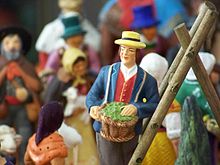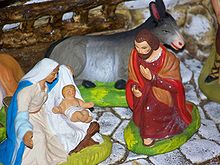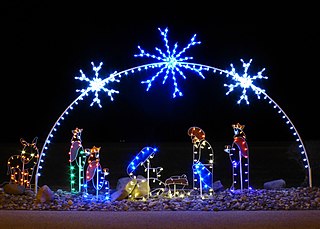
Christmas is an annual festival commemorating the birth of Jesus Christ, observed primarily on December 25 as a religious and cultural celebration among billions of people around the world. A liturgical feast central to Christianity, Christmas preparation begins on the First Sunday of Advent and it is followed by Christmastide, which historically in the West lasts twelve days and culminates on Twelfth Night. Christmas Day is a public holiday in many countries, is observed religiously by a majority of Christians, as well as celebrated culturally by many non-Christians, and forms an integral part of the annual holiday season.
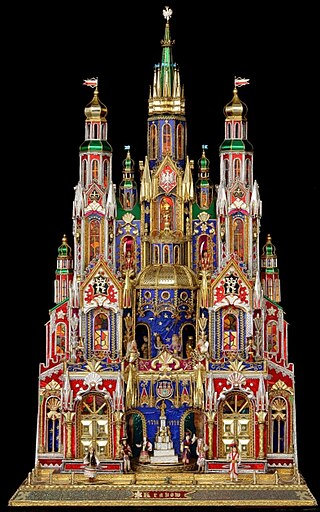
Christmas in Poland, known in the Polish language as Boże Narodzenie or Gwiazdka, is a major annual celebration, as in most countries of the Christian world. The observance of Christmas in Poland developed gradually over the centuries, beginning in ancient times; combining old Polish pagan customs with the religious practice introduced after the Christianization of Poland by the Catholic Church. Later influences include the mutual permeating of local traditions, lore, and folk culture. It is one of the most important religious holidays for Poles, who follow strict traditional customs, some of which are not found elsewhere in Europe.

Provence is a geographical region and historical province of southeastern France, which stretches from the left bank of the lower Rhône to the west to the Italian border to the east; it is bordered by the Mediterranean Sea to the south. It largely corresponds with the modern administrative region of Provence-Alpes-Côte d'Azur and includes the departments of Var, Bouches-du-Rhône, Alpes-de-Haute-Provence, as well as parts of Alpes-Maritimes and Vaucluse. The largest city of the region and its modern-day capital is Marseille.
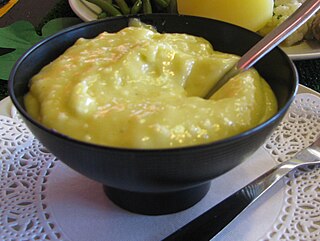
Aioli, allioli, or aïoli is a cold sauce consisting of an emulsion of garlic and olive oil; it is found in the cuisines of the northwest Mediterranean.

Christmas Eve is the evening or entire day before Christmas, the festival commemorating the birth of Jesus. Christmas Day is observed around the world, and Christmas Eve is widely observed as a full or partial holiday in anticipation of Christmas Day. Together, both days are considered one of the most culturally significant celebrations in Christendom and Western society.

In the Christian tradition, a nativity scene is the special exhibition, particularly during the Christmas season, of art objects representing the birth of Jesus. While the term "nativity scene" may be used of any representation of the very common subject of the Nativity of Jesus in art, it has a more specialized sense referring to seasonal displays, in particular sets of individual sculptural figures and props that are arranged for display.
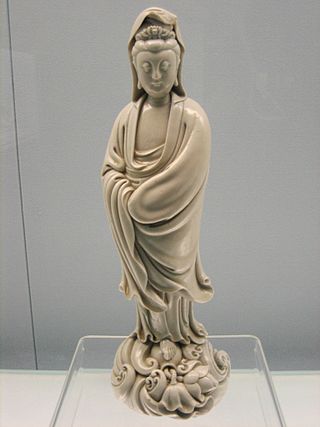
A figurine or statuette is a small, three-dimensional sculpture that represents a human, deity or animal, or, in practice, a pair or small group of them. Figurines have been made in many media, with clay, metal, wood, glass, and today plastic or resin the most significant. Ceramic figurines not made of porcelain are called terracottas in historical contexts.
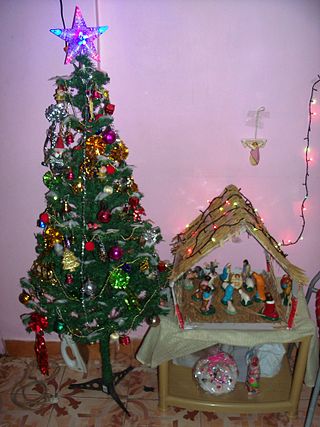
Christmastide, also known as Christide, is a season of the liturgical year in most Christian churches.
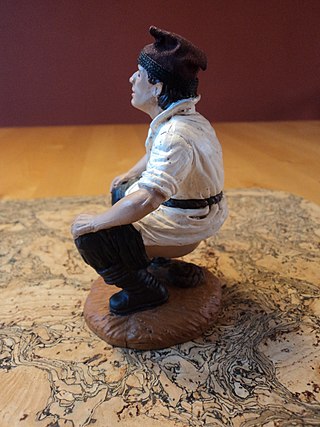
A Caganer is a figurine depicted in the act of defecation appearing in nativity scenes in Catalonia and neighbouring areas such as Andorra, Valencia, Balearic Islands, and Northern Catalonia. It is most popular and widespread in these areas, but can also be found in other areas of Spain (Murcia), Portugal, and Southern Italy (Naples).

The observance of Christmas around the world varies by country. The day of Christmas, and in some cases the day before and the day after, are recognized by many national governments and cultures worldwide, including in areas where Christianity is a minority religion which are usually found in Africa and Asia. In some non-Christian areas, periods of former colonial rule introduced the celebration ; in others, Christian minorities or foreign cultural influences have led populations to observe the holiday.

A Christmas decoration is any of several types of ornamentation used at Christmas and the greater Christmas and holiday season. Typical images on Christmas decorations include Baby Jesus, Mother Mary, angels, Father Christmas, Santa Claus, and the star of Bethlehem. Advent wreaths, nativity scenes, illuminations, and Moravian stars are popular Christmas decorations.

The farandole is an open-chain community dance popular in Provence, France. It bears similarities to the gavotte, jig, and tarantella. The carmagnole of the French Revolution is a derivative.

Allauch is a French commune situated east of Marseille in the department of Bouches-du-Rhône in the Provence-Alpes-Côte d'Azur region of France.

Kraków szopki or nativity scenes are a Christmas tradition originating from Kraków, Poland, and dating back to the 19th century. An unusual and characteristic feature of the szopka is the use of historical buildings of Kraków as a backdrop for the Nativity of Jesus. In 2018, it was inscribed on the list of UNESCO Intangible Cultural Heritage of Humanity.
La Coupo Santo, in full La Cansoun de la Coupo in original modern norm Provençal is considered the anthem of the Félibrige. It is sung in Provençal, one of six Occitan dialects.

The winds of Provence, the region of southeast France along the Mediterranean from the Alps to the mouth of the Rhone River, are an important feature of Provençal life, and each one has a traditional local name, in the Provençal language.
Baby Jesus theft is the theft of figurines of the infant Jesus from outdoor public and private nativity displays during the Christmas season. It is an "enduring practice" according to New York Times journalist Katie Rogers, "believed to be part of a yearly tradition, often carried out by bored teenagers looking for an easy prank." Sometimes these are stolen for resale, other times the associated pranks are more involved and include dropping it off somewhere else.

Christmas in Mexico is observed from December 12 to January 6, with one additional celebration on February 2. Traditional decorations displayed on this holiday include nativity scenes, poinsettias, and Christmas trees. The season begins with celebrations related to the Virgin of Guadalupe, the Patroness of Mexico, followed by traditions such as Las Posadas and Pastorelas.

Christmas in France is a major annual celebration, as in most countries of the Christian world. Christmas is celebrated as a public holiday in France on December 25, concurring alongside other countries.

Christmas traditions include a variety of customs, religious practices, rituals, and folklore associated with the celebration of Christmas. Many of these traditions vary by country or region, while others are practiced virtually identically worldwide.
